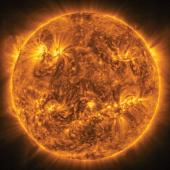Grand Prism
Exploring the color spectrum of the winter sky.
Frigid, snowy Montana winters start out cheery enough with the holiday season—until the long, cold slog to spring sets in after New Year’s. But the winter sky remains stubbornly festive all season long with the best assemblage of bright, sparkly stars the heavens have to offer. And they’re colorful too, if you know where and how to look.
Start with the Big Guy, Orion the hunter, who hoists himself up into the southeast by December nightfalls. By mid-February, he sits due south when it gets dark. The mythical Greek nimrod is easily identified by his bright, slanted belt of three white stars inside a starry rectangle. But the rectangle stars are not all white; the upper left-hand star marking his shoulder is Betelgeuse, and it’s distinctly red-orange. Binoculars will give you a better view, enhancing its ruddy color.
Red stars have the coolest surface temperatures; Betelgeuse is about 6,000 degrees Fahrenheit, compared to our yellowish sun’s 10,000 degrees. The reason it’s so bright is because it’s an old, bloated supergiant. And it’s huge: if it replaced our sun, it would engulf all of the planets out to Jupiter.
Trace Orion’s belt down and left and you run into Sirius, the dog star—and a dog indeed to many cultures besides the Greeks.
Now look at the lower right-hand rectangle star, marking Orion’s ankle. This is Rigel, a young, fiercely burning giant about 80-times the sun’s diameter. Its surface is very much hotter, about 21,000 degrees, and it glows bluish-white, though the color is very subtle.
Now check out the brightest stars around Orion. Trace Orion’s belt down and left and you run into Sirius, the dog star—and a dog indeed to many cultures besides the Greeks. The Cherokee, for example, made it one of the canines guarding the Path of Souls—the Milky Way. (The other was Antares, another red supergiant that guards the summer end of the path.) Twice the sun’s diameter and one of the nearest stars to us (and the brightest in the sky), Sirius burns white, about 18,000 degrees on its surface.
Up and left of Sirius, and making a big triangle with it and Betelgeuse, is Procyon, the brightest star in the constellation of the Lesser Dog. It’s another near star whose 11,000-degree surface gives it a slight yellowish cast. Next look above Procyon (up and left of Orion) for Gemini the Twins—a long rectangle of stars with two bright ones at the far end marking the twin’s heads. The lower, Pollux, is pale orange; and the upper, Castor, is white.
Now go back to Orion’s belt and trace up and right, and you’ll encounter Taurus the bull’s v-shaped face containing Aldebaran, a red giant. And above Orion, balanced on the horn tip of Taurus, is the pentagon of Auriga the charioteer, whose brightest star, Capella, glows yellow.
Up and left of Sirius, and making a big triangle with it and Betelgeuse, is Procyon, the brightest star in the constellation of the Lesser Dog.
As mentioned above, binocular magnification is useful in giving a better sense of the colors—most are admittedly subtle except for the red and orange stars, whose hues hit you right in the eye.
While you have those binoculars, have some colorful fun with twinkly Sirius. All stars twinkle as their light gets refracted through our atmosphere—that is, bent this way and that in the restless layers of the air. If you catch Sirius just after it rises when it’s near the southeast horizon (around 8:30pm in mid-December; 6:30pm in mid-January), and if the air is jumpy, the star will put on quite a show. Its fierce refraction will momentarily isolate individual parts of its spectrum of starlight, making it flash all the colors of the rainbow in turn. Binoculars will enhance the kaleidoscopic display.
So—winter’s dreariness got you down? If the night is clear, bundle up, grab those binoculars, and let the colorful stars of winter cheer you out of the frosty doldrums. After all, how far away can colorful spring really be?
Jim Manning is the former executive director of the Astronomical Society of the Pacific. He lives in Bozeman.










